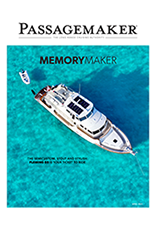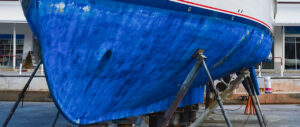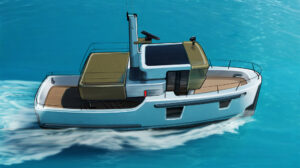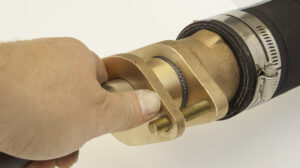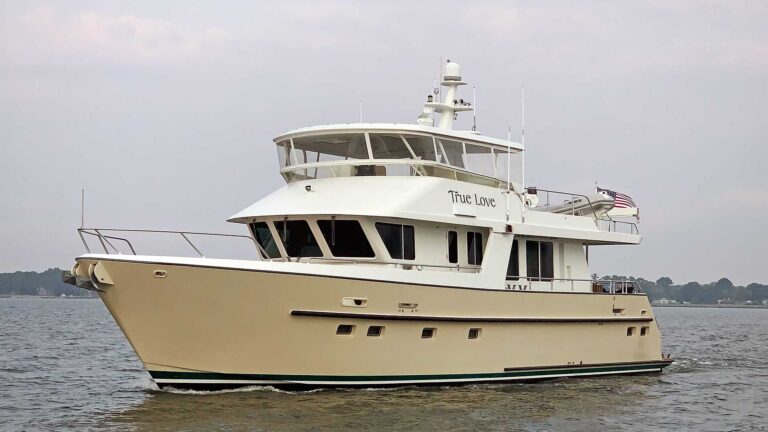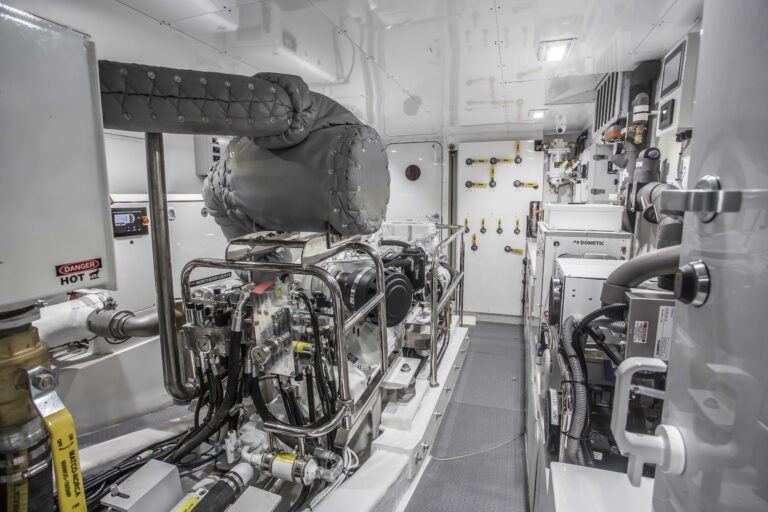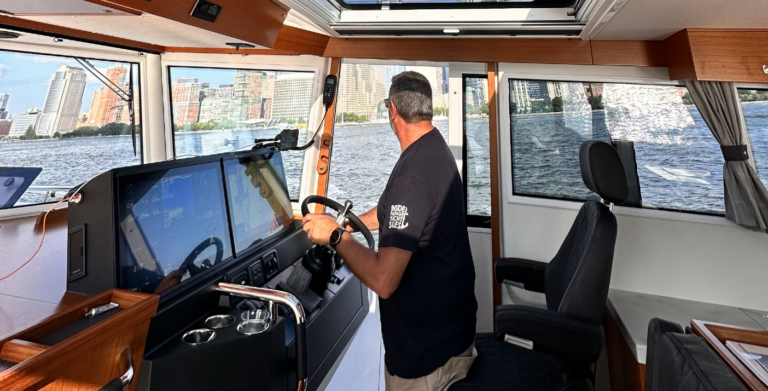Four and a half years. Six days a week. Eight hours a day, everyday. All told, roughly eight thousand hours of personal commitment. It’s not for everyone, and those who lack perseverance need not apply. But what can you get from such an effort?
For John McDowell of Ontario, Canada, his commitment resulted in a beautiful and rugged lobster boat cruising motorboat. A real salty 42′ motorboat for living aboard and cruising fulltime, complete for under US$100,000.
It mirrors a typical situation. Couples dream of passagemaking, but many can’t (or won’t) commit to the expense of a new, shiny production boat. For some, budget is the issue, others simply want a motorboat that is truly unique, built just for them. It has always struck me that almost all of us consider the do-ityourself route at one time or another, even if only for a fleeting moment.
I got a chance to see McDowell’s new yacht, Island Prince, during her maiden journey down the U.S. East Coast, on her way south to the Bahamas to spend the winter. John and his wife Diane had Island Prince tied up alongside the Shrimp Box Restaurant in Manasquan, New Jersey, the only pleasure boat among several large commercial fishing boats on this section of the New Jersey coast.
What I saw was a tribute to John McDowell, and the spirited independence known to many trawler owners.
It Started A Long Time Ago…
John McDowell is no newcomer to boats and the lure of the sea. In fact, he has been around boats all of his life. It runs in the family, too, as his uncle was head captain of the marine ferry system for Canada’s Maritime Provinces.
Among John’s boating adventures are several ocean kayak trips to Greenland, the Arctic Circle, British Columbia’s Vancouver Island, and Lake Superior in mid-winter. Great stuff.
As retirement finally loomed on the horizon for McDowell and his new wife, John began a search for a boat that would take him on more adventures, but with a high degree of comfort and livability. Small boats and kayaks don’t exactly fit that equation, so he instead focused on the cruising motorboat/trawler, and the search began in earnest.
Looking for a comfortable trawler is easy enough, but John did not have the budget for a big, new production trawler. He liked the look and feel of a full displacement boat, but he also liked the look of the fishing boats that ply the waters off Canada. The lobster boats especially caught his eye.
Somewhere along this path of inquiry, John decided that he would have to build the boat himself, in order to get a unique craft for himself and his wife, as well as to ensure the level of finish and comfort he demanded.
Unfortunately, there didn’t seem to be any full displacement hulls available for owner completion anywhere near his Ontario home, so he widened his search to include commercial semi-displacement fishing boat hulls.
Finding The Right Builder…And Boat
If you ever look for them, you’ll quickly find the enormously popular commercial hulls offered throughout Canada’s Maritime Provinces for fishing and catching lobster. The down east style has quite a following on the east coast of North America as well. Go to any harbor in Nova Scotia or Maine and you’ll see hundreds of these boats. They have proven themselves to generations of seagoing men and women, and fit the rugged demands of these waters.
Thankfully, McDowell was realistic about never wanting to cross oceans, so he checked out builders of these semi-displacement lobster boat hulls, rather than maintaining his requirement for a full displacement passagemaker.
After careful consideration and numerous visits to different boat yards in Canada, John selected Provincial Boat and Marine on Prince Edward Island. As John soon found out, Provincial is known for quality work, and their reputation for not taking shortcuts was enough to convince McDowell that they could build him a hull. That was in 1993.
“This efficient twelve-man company has an excellent reputation for quality workmanship and they were willing to modify to my requirements,” John told me. “So I had them build a hull without cabin sole, deck, or overhead. They installed the stringers and cross members, and four fuel tanks. Then they added the Cummins diesel engine, shaft and running gear, and rudders-but without steering and engine controls.
“I watched throughout this phase of the project, and then my wife and I drove the escort vehicle as the new hull was transported by truck some 1,500 miles to our home on Lake Huron in Ontario.”
The construction baton now passed to McDowell, who tells us his story of the project.
John Builds Island Prince
My first task was to construct a temporary frame shack over the hull. This I covered with cheap plastic tarps. Working from my own sketches, I spent a lot of time trying to get the cabin lines and the interior layout to my liking. This was in the fall of ’93, and we launched the boat in the spring of 1998.
I estimate I spent about 8,000 hours on the project. As I write this, we are in the Bahamas and have cruised 5,000 miles in the last four months. The boat and systems operate as expected, and handling in head seas and her top speed are both better than anticipated.
I followed author Ernest Gann’s philosophy and designed the boat to sleep two, eat four, and drink six. The following are some features that I incorporated into Island Prince:
Offset Saloon – This gives a protected and safe walkway from the cockpit to the foredeck without going through the cabin, and still allows a relatively wide saloon. There is also easy access to the top deck from the sides of the wheel house opposite the walkway. I like this feature, but it involved a lot more labor than I expected.
Forward Raked Windshield – This reduces the greenhouse effect and gives a cooler wheelhouse. There is no glare on the instruments or on the windshield. It adds uniqueness to the styling and this attracts attention. If you like meeting people, then design a unique boat.
Bulwarks – I dropped the foredeck below the sheer at the bow about eight inches and tapered it amidships. This is a great safety feature.
Raised Wheelhouse – This gives excellent all-around visibility, easy side deck access, and increased headroom in the engine room. Also, it allows the galley counter to be inset under the wheelhouse bench seat about one foot, thus increasing the effective length of the boat.
Wheelhouse Hatches – I put a large hatch in the overhead and dual hatches in the sole. This allows easy engine removal if ever required, and full headroom in the engine room for major work. Movement of heavy items (batteries, genset) is much easier.
Covered Aft Deck – A great feature. Provides an area sheltered from sun and wind when under way or at anchor. The upper boat deck area is increased (about 12′ by 18′) for dinghy storage or sunning.
Transom Door – I cut a large door in the transom and hinged it out. Then I clip a ladder on, and the cockpit becomes a swim platform without the added length, dockage costs, and noise (wave slap at anchor) of a swim platform extension. The open door makes for a very convenient loading and unloading of the tender. I’ve even installed the outboard on the door sill and use it a s a simple but effective get home system.
Mast & Boom – I purchased a used 27′ sailboat mast and cut it up with a hacksaw. Then I cut brackets from 1/4″ aluminum plate and had a friend weld them up. I purchased a simple swaging tool and then made up the guy wires. A trailer winch was bolted onto the boom. The mast provides increased height for mounting antenna and lights, and the boom is a good one-person system for launching the dinghy.
Suggestions From A Home Builder
Full displacement trawlers make the ideal cruiser, but new ones are expensive, and used ones sell at premium prices. Being lighter, a semi-displacement boat is cheaper to produce.Lobster boat hulls are seaworthy, handle well even at slow speeds, are relatively economical to operate, and can go faster when required. These boats are readily available to any stage of completion, so they make good projects.
My boat might be a bit ambitious for an amateur builder, but if you follow my suggestions, a suitable cruiser could be built by any dedicated handyperson.
Buy a well-built hull from a reputable builder. There are literally dozens of lobster boat style boat builders in the Northeast. Visit a few yards and you will quickly learn that there is a wide range of quality and price among the available builders.
Buy the largest forward cabin and wheelhouse that the builder offers and the widest washboards (these are the 16″-wide work decks along the sides and transom of a lobster boat).
Have the running gear professionally installed, aligned, and tested.
You can extend the wheelhouse yourself to within about six feet of the transom, using laminated wood beams and marine plywood. Cover the outside of the structure with fiberglass cloth and epoxy. Sand this smooth then apply a good marine paint with a roller. It’s best to avoid exposed wood on the exterior.
You can design your own interior and build in all cabinets and furniture. Paint the interior white and use varnished wood for trim and cabinets.
Put steps from the cockpit to the washboards on each side, and install handrails along the cabin top.
Install the various systems while keeping them as simple as possible. Also, it’s a good idea to build-in access to all area of the hull for storage and safety.
What I Learned…Some Building Tips
You will need an enclosed building for your project. A plastic-covered shack will do, but try to install a roof that will last. I didn’t, and suffered troublesome leaks.
Have the project near your residence. A heated building is not necessary if you have a heated garage nearby to fabricate pieces. Avoid white oak and teak. Both are very hard on tools and glue poorly. Instead, use laminated cedar for beams and mahogany for cabinets and trim. These woods are a joy to work with and also easy to finish. White ash and any hard, dark wood make a beautiful cabin sole.
If you’ve never worked with fiberglass and epoxy before, buy a copy of Canoecraft. This softcover book details construction of cedar strip canoes, and has a superb section on fiberglassing.
Be careful with direct contact with epoxy. If you develop an allergic reaction as a result, your boat building will be severely restricted. Use lots of ventilation, and always use rubber gloves and masks. Vinegar is a much better cleaner than solvent to clean epoxy from your hands and the rest of your body.
As for tools, you will need the usual hand and power tools, plus innumerable clamps. A circular grinder makes quick work of roughing up fiberglass for bonding. A six-inch random orbital sander (such as Porter Cable Model 7336) is also an absolute must. These sanders do a smoother job in less time than either belt or vibrating sanders.
The availability of marine supplies at fair prices was a big problem during the construction of Island Prince. I had wholesale (?) prices quoted to me that were over five times what I bought the identical part for elsewhere. You must shop around and get discounts to keep costs down. Most suppliers will readily give 10% discounts and some will give 40% and occasionally 60% off list to good customers.
I found fiberglass and stainless steel products to be cheaper in Canada than in the U.S.
You will have to buy wood products locally. Watch for trees being removed and you may get good lumber for the cost of milling.
Costs…Or Where Does The Money Go?
I kept detailed records of all money spent. I have rounded the totals slightly and converted the dollars from Canadian to U.S. (at an exchange rate of $0.67). All costs are shown as U.S. dollars. This is a breakdown of what Island Prince cost to build:
Hull, with stringers and fuel tanks $17,700
Ports, windows, railings, mast 6,600
Lumber 7,300
Fiberglass cloth, epoxy, fillers 4,200
Coatings -paint, varnish, sealants 2,400
Engine, gears, prop, shaft, exhaust 21,300
Steering pump, rudder, ram, hoses 2,300
Fuel filter, fillers, hose, gauges 1,900
Ventilation fans, blowers, hoses 200
Electrical system, inverter, charger 6,700
Electronics, radar, sounder, radio 11,800
Water system and all plumbing 2,800
Hardware, hinges, bolts, screws 2,700
Appliance stove, fridge, heat, freezer 2,700
Upholstery, blinds, sewing 900
Mooring cleats, anchors, rode 3,300
Safety life rings, extinguishers, bell 700
Documentation -survey, registration 500
Consumables -brushes, thinner, gloves 400
Custom fees, shipping, launch fees 1,100
Total (in U.S. dollars) $97,500
(Not included are initial hull transportation, cost of boat shed, spares, tools, and construction insurance. These can vary widely from builder to builder.)
Onboard Island Prince
Walking around Island Prince, it’s clear John McDowell took his time and performed his numerous roles-woodworker, electrician, plumber, mechanic, painter, designer-with dedication. The boat is thoroughly clean, simple, and quite cozy. And she’s proven to be a great cruising home, from Canada to the Bahamas.
Except for a future genset installation, she is a completed yacht in every way. I asked John about the personal side of the enormous singlehanded effort. McDowell had previously built two homes, so his general skills are perhaps a bit more exercised than your average boater. But he quickly admitted he is no carpenter or cabinetmaker. And he left all welding to an experienced professional.
What was the hardest part of building the boat? John answered that getting parts, and trying to keep supplies in stock during a particular activity, was easily the most difficult- like running out of the right size screw and having to stop a task to reorder more.
Did he enjoy the project that took him six days a week for four and a half years? Absolutely, except for the tedious job of sanding. That got old early on.
And the biggest question of all…would he do it again?
“I hope I never have to,” John retorted with a laugh. Once was enough, thank you.
I think you’ll agree that Island Prince reflects a certain style of boat, and a certain kind of person, with tenacity and vision to bring it to life. There are many similar projects that never made it…incomplete boats waiting helplessly in yards around the world.
The dream is the easy part. Making it come true is much more difficult. But when and if the dream does come together, as on Island Prince, the rewards are immeasurable. Truly one of life’s treasures.
Great job, John, and fair winds to the crew of Island Prince.
